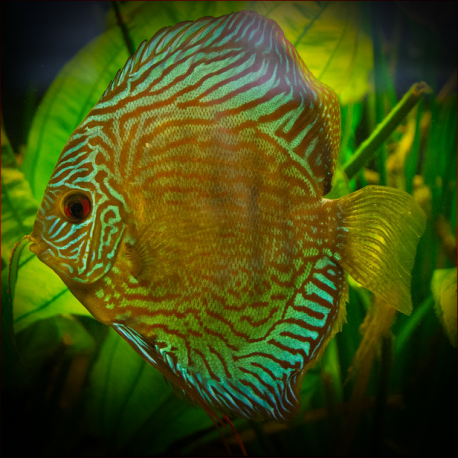More info
Datasheet
| Minimum Tank Size | 255 litres / 67.36 US gallons |
| Maximum Size | 26.0cm / 10.24inches |
General Description
The Discus (Symphysodon aequifasciatus) is a species of cichlid within the Perciformes order. It can grow up to 26.0cm in size and is known for its vibrant and striking coloration. This species is commonly found in slow-moving tributaries and forest pools in the Amazon river basin, preferring deep and sheltered areas with ample vegetation.
Aquarium Setup
For housing Discus, a tank size of at least 255 litres is recommended. Many enthusiasts opt for a heavily planted aquarium setup to provide sufficient cover for the shy and skittish nature of Discus. This setup mimics their natural habitat, providing them with a sense of security. Details can be found in the table below.
Behaviour
Discus are known to be shy and skittish fish, often forming schools in the wild. They prefer to stay in deep waters around tree roots and rocks, seeking shelter and security within their environment. Due to their timid behavior, ample hiding spots and dense vegetation are crucial in an aquarium setting to ensure their well-being.
Feeding and Diet
In their natural habitat, Discus primarily feed on zooplankton, insects, and other small invertebrates. When kept in an aquarium, they can be fed a diet of high-quality pellets or flakes, supplemented with frozen or live foods like bloodworms and brine shrimp. Providing a varied diet is essential to maintain their health and vibrant coloration.
Reproduction & Dimorphism
During the breeding season, Discus form pairs and exhibit strong parental care. Both parents work together to protect their eggs and fry. In terms of dimorphism, male and female Discus can be distinguished by slight differences in body shape and markings, with males typically being slightly larger and more brightly colored than females.
Habitat and Distribution
The native range of Discus spans the Rio Solimões and the main Amazon river, stretching from Colombia and Peru to the Rio Tocantins drainage in Brazil. They are often found in slow-moving waters with dense vegetation, avoiding main river channels. Populations of Discus have also been introduced in countries like Guyana and Suriname, adapting to various aquatic environments.

